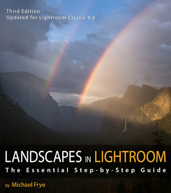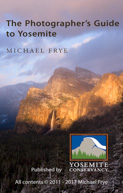Yosemite Photo Conditions
by Michael Frye | Mar 5, 2015 | Yosemite Photo Conditions
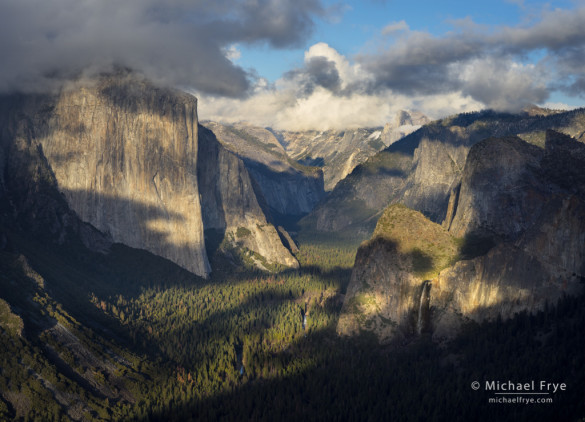
Late afternoon view of Yosemite Valley from near Old Inspiratoin Point, Monday afternoon
It’s the time of year when both El Capitan and Bridalveil Fall get late-afternoon sunlight when seen from the west end of Yosemite Valley. In winter, El Cap get that late-day light, while Bridalveil stays in the shade. In summer it’s the opposite, with the cliffs to the right of Bridalveil Fall (like the Leaning Tower) receiving the last glow in the evening, while El Cap goes into shade earlier. But in early March (and around the end of September) the light balances well on both sides of the valley, making it a great time of year for photographs from Tunnel View and Gates of the Valley (aka Valley View).
Knowing this, I watched the weather closely on Monday. Some showers moved through, and it seemed like the last chance of seeing interesting clouds for awhile, so I decided to hike up above Tunnel View to a spot near Old Inspiration Point (I’ve described previous journeys up this trail here and here). I got there in time to catch one moment with beautiful cloud shadows. I especially like the shadow near the bottom of El Capitan (in the photo above).
(more…)
by Michael Frye | Mar 1, 2015 | Yosemite Photo Conditions
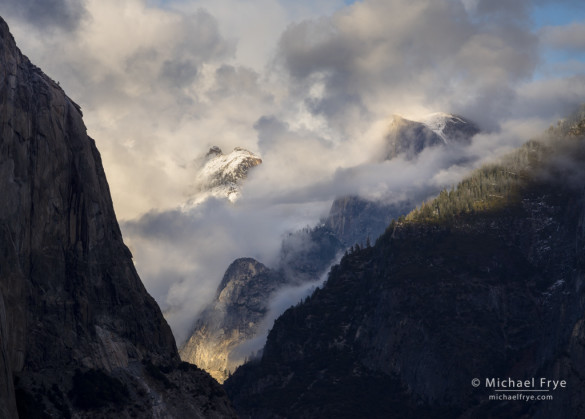
Half Dome and clouds from Tunnel View, Yosemite NP, CA, USA
“Time, geologic time, looks out at us from the rocks as from no other objects in the landscape… Even if we do not know our geology, there is something in the face of a cliff and in the look of a granite boulder that gives us pause.” — John Burroughs
Photography has a great ability to showcase contrasting textures, which is perhaps why hard rocks and soft clouds fit together so well. In Yosemite the rocks are a given; they’re always there. It’s the clouds that are more elusive, especially during these dry years.
(more…)
by Michael Frye | Feb 24, 2015 | Yosemite Photo Conditions
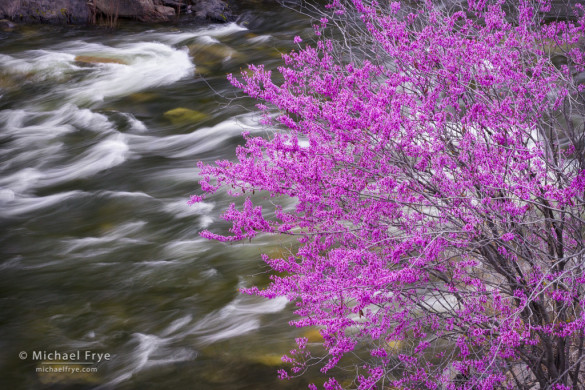
Redbud along the Merced River, Merced River Canyon, March 2013
February has been exceptionally warm, so I probably shouldn’t be surprised to see signs of spring already. But redbuds? In February? Apparently so. Claudia drove up to Yosemite Valley on Saturday, and reported seeing redbuds and a few poppies blooming in the Merced River Canyon west of the park. It’s not unusual to see poppies in late February, but the redbuds are a month early. Claudia said that only a couple of them were in full bloom, but many more were starting.
Temperatures dropped significantly over the weekend, and I’m not sure how that will affect the redbuds, or the poppies. Under normal circumstances the redbuds would continue to progress, and reach peak in perhaps a week or so. But these aren’t normal circumstances, so all bets are off.
(more…)
by Michael Frye | Feb 22, 2015 | Yosemite Photo Conditions
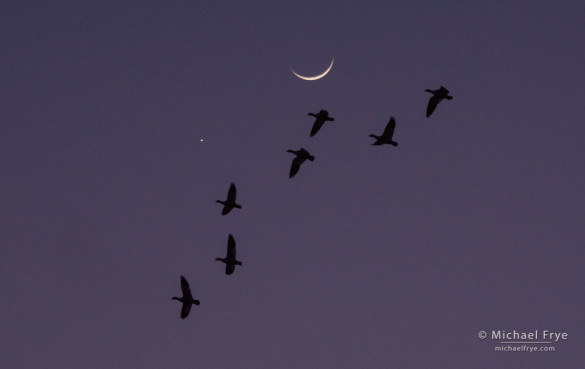
Moon, Venus, and Ross’s geese, San Joaquin Valley, CA, USA
I’ve been working on a book deadline, so haven’t been able to get to Yosemite Valley and check on Horsetail Fall recently. But I did break away from the desk on Friday to go down to the Central Valley and photograph birds. At first the light was rather uninspiring, because the fog I was hoping for had lifted into a low overcast. But it turned out to be a great day. I photographed one of the biggest goose takeoffs I’ve ever seen, with perhaps 30,000 birds lifting off at once; one of the photographs below shows part of that group. Later, the sun broke through the stratus deck to create some beautiful sunbeams, and at dusk Venus and the crescent moon appeared (above).
As for Horsetail, the flow diminished quickly after the last rainstorm, and from reports I’ve heard there is basically no water in it – just a bit of dampness. There is another storm predicted for today and tomorrow. This is expected to be both colder and weaker than the last storm, with snow levels around 6,000 feet, but limited moisture. Horsetail might get some help from this system, but probably not much. Even if this storm turns out to be bigger than predicted, any precipitation in Horsetail’s drainage will fall as snow, so there won’t be a significant boost in flow until the sun comes out and melts some of that snow. It’s supposed to be sunny Tuesday, Wednesday, and Thursday, so maybe by Wednesday or Thursday we could see a decent water flow in Horsetail.
(more…)
by Michael Frye | Feb 10, 2015 | Yosemite Photo Conditions
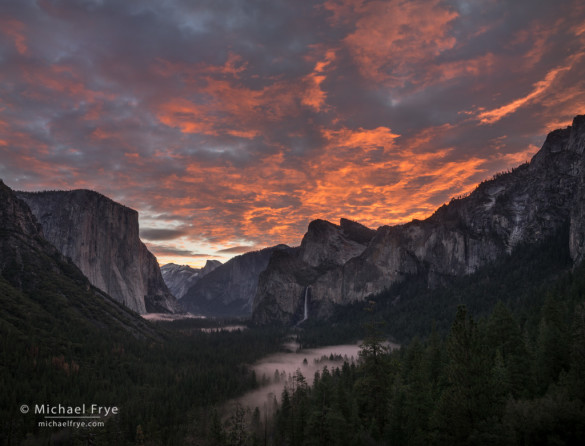
Sunrise from Tunnel View, Sunday morning
Yosemite Valley got about three inches of rain from the storms over the weekend. That’s not a drought-busting amount, but it helps, and I’m grateful for every drop.
The first wave of rain arrived Friday night, and lingered through Saturday. Early Sunday morning I looked at the satellite and radar images online, and saw thin, high clouds moving in ahead of the next system. Thinking that those clouds might light up at sunrise, I made the trip up to Tunnel View. Soon after I got there a bit of color appeared behind Half Dome, and then within minutes the whole sky caught on fire. It turned into the most colorful sunrise I’ve ever seen from that spot; you can see a photograph above.
The second wave of rain arrived Sunday evening. It started slowly, but around 9:30 p.m. a band of heavy rain passed through Mariposa County and headed toward Yosemite. I was actually out driving during this squall, and had to stop and pull off the road four separate times because it was raining so hard I could only see about 20 feet ahead.
(more…)
by Michael Frye | Feb 6, 2015 | Yosemite Photo Conditions
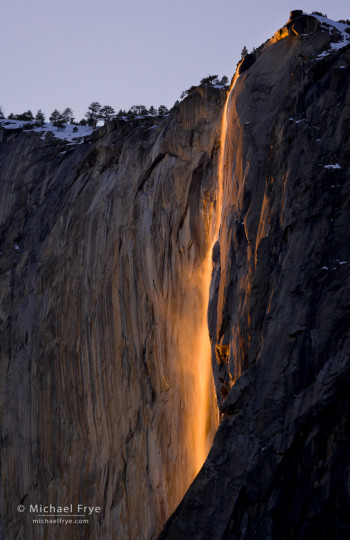
This photograph from 2009 shows what an average February flow in Horsetail Fall looks like
After a wet spell in December, the rain spigot got turned off. Yosemite Valley received seven one-hundredths of an inch of rain for the entire month of January. San Francisco set a record for January that can never be broken, with no measurable precipitation.
Not surprisingly, there isn’t much water in Horsetail Fall. In fact there’s no detectable flow at all – just a little dampness near the top. But forecasters are predicting a significant storm this weekend. They’re actually expecting two pulses, one tonight, and another on Sunday night. Total rainfall for the weekend could exceed four inches if the forecasts are right.
Horsetail should get a short-term boost from this storm. Whether that boost lasts longer depends on the exact snow level. Horsetail is fed by melting snow from a small drainage on top of El Capitan lying between 6,200 and 7,600 feet. The predictions for this storm put the snow level at 8,000 feet. If the actual snow levels are a little lower, and Horsetail’s tiny watershed gets some significant snow, then the runoff from that snow melting could last for a couple of weeks and provide at least some flow during the prime photography period later this month. If the snow levels are higher, and Horsetail’s drainage gets only rain, the water will run off quickly and won’t provide a lasting increase in the flow.
(more…)













